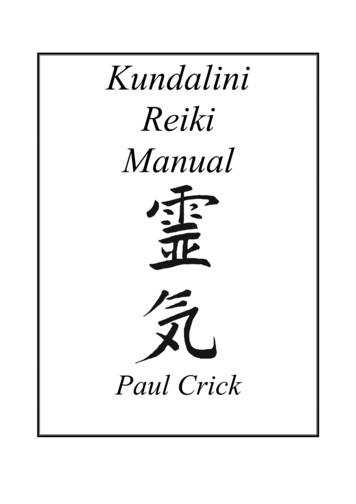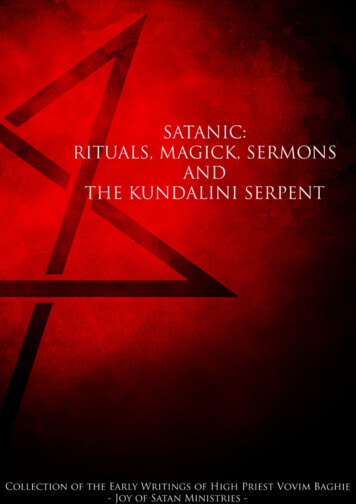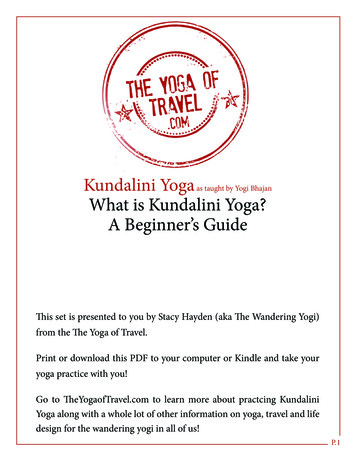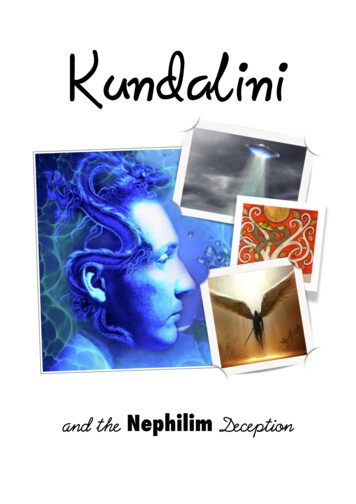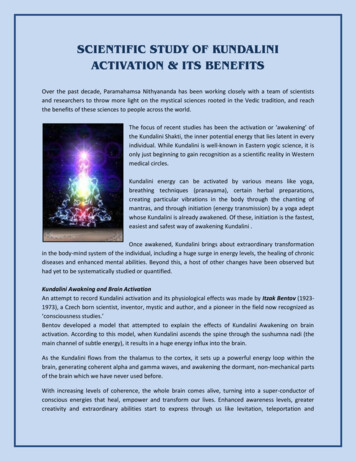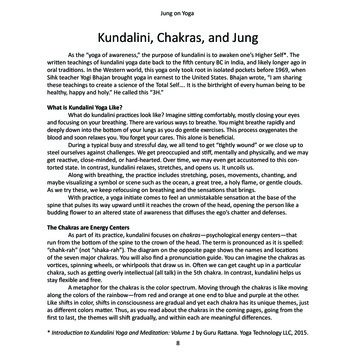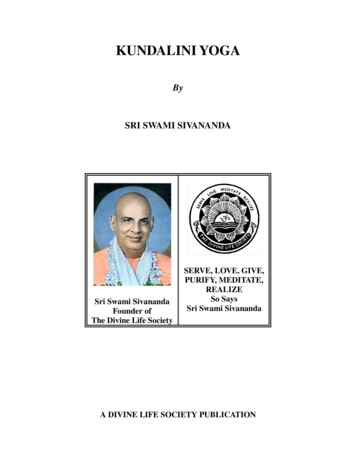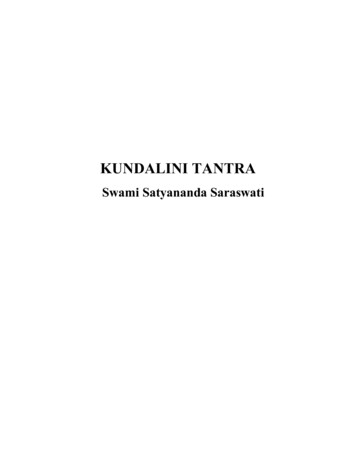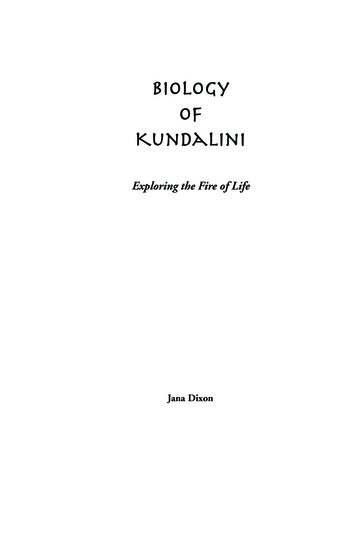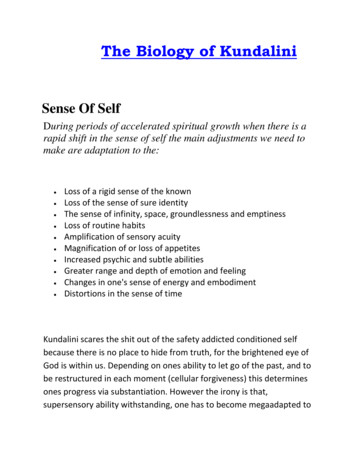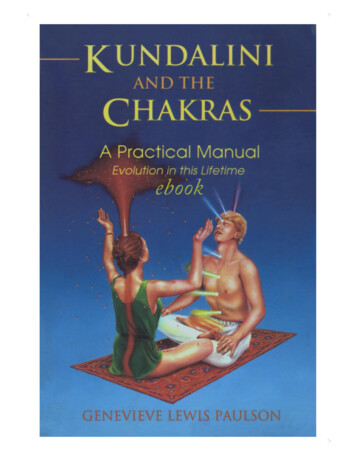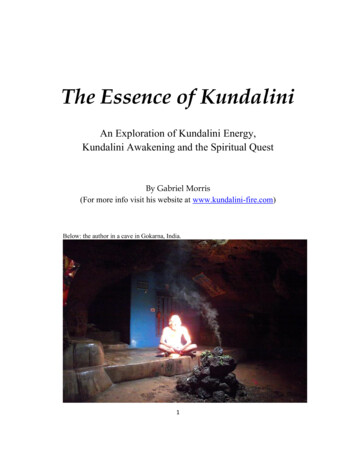
Transcription
The Essence of KundaliniAn Exploration of Kundalini Energy,Kundalini Awakening and the Spiritual QuestBy Gabriel Morris(For more info visit his website at www.kundalini-fire.com)Below: the author in a cave in Gokarna, India.1
Copyright Gabriel Morris 2011Other books by Gabriel Morris:*Kundalini and the Art of Being (in paperback on Amazon.com; as an ebook for 5; or as a free e-book included with all of Gabriel’s other books below)*The Mystery of Woman: A Book for Men (e-book 8; paperback 15)*Following My Thumb: A Decade of Unabashed Wanderlust (e-book 8;paperback 14)*I Leapt Into the Night, And Ten Other Stories (included as part of FourBooks in One, below)*Don’t Push the Road: Random Ramblings of a Travel Junkie (includedas part of Four Books in One, below)Special deals:*Three Books in One This compilation includes three complete books byGabriel Morris: Following My Thumb, The Mystery of Woman and Kundalini andthe Art of Being (available in one paperback for just 21, with Kundalini and theArt of Being as a separate e-book)*Four Books in One This compilation includes four complete books byGabriel Morris: Following My Thumb, I Leapt Into the Night, Don’t Push the Roadand Kundalini and the Art of Being (e-book 15; paperback for just 20, withKundalini and the Art of Being as a separate e-book)All books are available at my e-store on Lulu.com. E-books can bedownloaded right away as a PDF file. Paperbacks are high quality and can beshipped worldwide. Lots more info here:www.lulu.com/spotlight/GabrieltravelerAlso, feel free to share this free e-book with others! Either forward the PDFfile itself by attaching it in an email, or else share the link for my main website:www.kundalini-fire.com2
Table of ContentsChapter 1. What is Kundalini?Chapter 2. How Does One Awaken Kundalini?Chapter 3. Explore the World WithinChapter 4. Seek Out the Dark and Dusty RealmsChapter 5. The ChakrasChapter 6. Masculine and FeminineChapter 7. Honoring the BodyChapter 8. MeditationChapter 9. SexualityChapter 10. The Essence of Kundalini3
(Chapter 1 of this book was previously published in the August 2010issue of the Sedona Journal of Emergence, in slightly different form.)Chapter 1. What is Kundalini?More than fifteen years ago, when I was twenty-two, I experiencedsomething known as a kundalini awakening. When it happened, I had no idea whathad occurred. I didn’t have a spiritual teacher or a guru on the somewhatmeandering spiritual path I’d embarked on a few years earlier. I’d startedpracticing hatha yoga, read voraciously everything from The Tibetan Book ofLiving and Dying to Carlos Castaneda to Journeys Out of the Body, meditatedalone in the desert, fasted for days at a time, practiced emotional clearing, went tovarious workshops and spiritual gatherings and in the process met many others alsoreaching for a higher state of consciousness and a more meaningful experience ofbeing. It was still completely out of the blue and totally mind-blowing, literally,when I experienced my kundalini energy awaken, or arise.There are, of course, many different forms of spiritual awakening that canoccur to a person. Sometimes it’s simply a revelation or epiphany that sends one ina completely different direction, one focused more on spirituality and innersearching. Awakening can result in seeing angels or contacting and channeling analien entity. An experimental drug trip, such as in a teepee ceremony or sweatlodge, can lead to discovering and embracing a previously unknown part ofoneself, or even to communing with some aspect of the divine. Or an awakening4
can lead to the ability to see people’s auras, talk with the dead or leave one’s bodyto explore the astral planes.Kundalini awakening, however, is something else. It can come about as aresult of some of these types of experiences, and it can also lead to activating someof these otherworldly phenomena, and many others. In essence, kundalini is simplyenergy. Specifically, it is spiritual energy which resides in every human being.Kundalini means literally “coiled serpent”. Figuratively speaking the coiled serpentrepresents a reservoir of spiritual energy that lies at the base of the spine in the rootchakra, coiled up because in most people it is latent or potential spiritual energy,which the person is for the most part unaware of. Through yogic or other spiritualpractices this energy can be awakened in an individual, in which case the energybegins flowing upwards from the root chakra through all the chakras along thespinal column, invigorating and cleansing them; and finally culminating inunification with the uppermost crown chakra at the top of the head.Like the many forms of spiritual experiences in general, kundaliniawakening itself takes wildly different forms for different people. Thesedifferences can range from experiences of pure bliss to sheer terror, and everythingin between. The unifying element is that of this rising spiritual energy that awakensand activates the chakra system—those six or seven or more energy centers(depending on who you ask) located along the spinal column, each of whichcorresponds with some integral aspect of the human soul.In my case, the initial experience of kundalini was one of extreme innerchallenge, to say the least. One of the reasons this can occur is that kundalinienergy is like a fire hose of energy whose innate purpose is to cleanse the chakrasof any blockages or disturbances and bring them back to their full, vibratingpotential. And once switched on, it apparently cannot simply be switched back off.5
That certainly rings true in my case, after so many years of experiencing thepowerful intensity of this energy.Once the energy is gushing forth, rising up the chakra system, it will comeinto contact with each of the chakras. And if met with resistance—in the form ofblockages, past traumas, denied emotions and memories, guilt, judgments and allthe various frozen energy we hold in our human souls that keep us from vibratingfully—then the kundalini will awaken these hidden pains like a spotlight shininginto a dark and dusty attic.Kundalini energy has a single-minded mission, and that is to reunite with thecrown chakra. I say reunite because it is also a matter of returning ourselves to ouroriginal, natural state, that of oneness with all aspects of our multi-faceted souls aswell as with the spiritual realms beyond our normal, waking perceptions. Theprocess of this reunification is where things can get difficult and frightening, and atworse can seem nearly impossible to make sense of or resolve.As mentioned, the symptoms associated with kundalini are extremely wideranging. Some simply experience a stream of blissful energy that flows upwards toinvigorate their mind. Some might find themselves kept awake, unable to sleep fordays at a time, instead practicing art or music, inspired by a constant flood ofcreative energy. Others find themselves spontaneously assuming yogic positions orreciting chants, perhaps in languages they’ve never spoken or even heard before.Still others might find themselves gazing into otherworldly realms or dimensions,hearing voices, seeing non-physical entities, perhaps having visions of the future orelse peering into the ancient past.For many (such as myself) kundalini awakening can be a more localizedexperience that brings about a barrage of assorted energetic symptoms on thephysical, mental and emotional planes. These are oftentimes downright bizarre,6
and sometimes highly unpleasant or even excruciating. In my case, I experienced asensation as if a fire were burning at the base of my spine, raging up my spinalcolumn. I had electrical shocks occurring all throughout my body, and flashes oflight seemingly before my very eyes as well as outside of my normal field ofvision. And I felt as if I were simultaneously being crushed and pulled apart by apowerful force of energy that I couldn’t have previously imagined. For monthsafter my kundalini awakened, I experienced a constant onslaught of suchsymptoms, to the point that I was certain at the time there was no way that what Iwas going through could ever truly change and be resolved.Fortunately, I eventually came across a number of books explaining what Iwas experiencing; as well as a Buddhist teacher with some knowledge of thephenomenon. All of this helped assure me that there was a purpose to it as well assome sort of conceivable resolution to what I was going through. However,resolution in this case doesn’t mean that suddenly the experience ends and it’s allbehind you. As my Buddhist teacher informed me at one point in the depths ofthese overwhelming sensations:“The force of energy itself will not lessen in its intensity. However, you willeventually change to accommodate it. And then it will seem that the energy has infact changed.”Though that wasn’t exactly what I wanted to hear, almost two decades later Ican say that he was exactly right. The purpose of kundalini awakening is notsimply to give us an experience which we then look back on and say that itchanged us to some extent. Instead, its purpose is to awaken a source of spiritualenergy within our souls which will connect us with our full potential and bringabout an expanded consciousness and heightened awareness of both the worldaround us, and the infinite and eternal realms both within and far beyond us.7
Rather than simply shifting our mind and beliefs or our perspective, it brings abouta much more fundamental transformation of our very essence. Kundaliniawakening is not simply an epiphany or a revelation, a greater understanding ormore expanded perspective on life. It is a very real and palpable force of energythat is undeniable when it happens. Now, you may or may not necessarily knowwhat has actually happened, or what it really means or how to deal with it. Butwhen this energy awakens within you, you will know that everything has changedfor you and it will never be the same.I believe that contacting and awakening this energy is truly one of the mostimportant aspects of healing that humanity needs to undergo during this time ofmonumental upheaval and transformation on our planet. Why? Because, for all thechallenges associated with it, I’ve also experienced during brief glimpses of clarityand illumination the depth of blissful presence and all-encompassing wholenesswhich the awakened kundalini ultimately brings about. And in that state of onenessand knowing and connection with everything, there is no wanting for anythingelse, and the incessant problems that plague our world based on separation fromourselves cannot continue to haunt us.Humanity has come to a crucial crossroads, where we simply cannotcontinue going forward as we have for the past several hundred years ofaccelerating technological progress, unguided by a true connection with our innercore, and with the universe as a whole. Humanity needs to make a huge, criticalleap, an evolution of consciousness in order to begin relating with our world andwith each other in a completely different way: one that is deeply attuned with therhythms of the natural world, the unseen realms, and the multi-dimensionalcomplexity of the human spirit. And kundalini has the power to bring about thiscritical transformation of humanity, one person at a time.8
Chapter 2. How Does One Awaken Kundalini?First, I would simply like to state that I’m not an “expert” on kundalinienergy in any sense. I’m not a certified yoga instructor or yogi of any kind orsomeone trained by a teacher in kundalini energy, kundalini yoga or ancient Hindutexts, the oldest known writings on the phenomenon. I am simply an experiencer. Iwas a spiritual seeker and a wandering traveler who spontaneously experiencedkundalini awakening in the fall of 1994 when I was twenty-two years old; and so Ihave plenty of personal, in-depth experience with it. I’ve also, of course, read andstudied a lot about it in the course of those years of experience. So take that forwhat it’s worth in terms of what I have to say here. Ultimately, look withinyourself for the truth of what is right for you, because every person’s spiritual pathis different.So, how does one go about awakening their kundalini? My first answer toanyone asking this question would most likely be: “Don’t try to awaken yourkundalini!” Not a very helpful answer, I suppose. But there are several reasonswhy one shouldn’t focus too much on kundalini awakening, even as you becomemore aware of the reality of its existence and its potential impact on your state ofmind, your body and your soul.For one thing, trying to bring about the awakening of kundalini is like tryingto experience an orgasm. The more you focus on it, the more it eludes you.Because the very essence of its nature is such that it cannot be conjured andcommanded by mere thoughts in the mind. In fact, some teachers on the subjecthave suggested that freely flowing kundalini energy could even be equated in some9
sense to experiencing an ongoing orgasm. And I would agree that there issomething to that comparison, though I must admit that I have yet to achieve thatstate of experiencing my own kundalini flowing in a pure, uninterrupted state. ButI have certainly glimpsed momentarily at times over the years its potential towarrant that comparison.Continuing with the orgasm analogy for a moment, another reason not tofocus too much on the awakening of kundalini is that, like orgasm, if you focus onit too much then you’re liable to miss all of the other good stuff that can beexperienced in leading up to it, or else instead of it. In other words, there are manyspiritual states of awakening, revelation, ecstasy, bliss, oneness, etc. which can beexperienced, explored and learned from, independent of kundalini awakening.More important than anything on the spiritual quest is simply to be fully in themoment, with whatever it is that you’re experiencing, rather than looking forwardin anticipation to something that may or may not ever come about.And there’s one more important reason not to focus too much on kundalini:which is that kundalini energy is a very powerful force that, as my own personalstory illustrates, can be intense, overwhelming and even dangerous if encounteredprematurely. It shouldn’t be forced, but instead should be allowed to awakenwithin an individual naturally, of its own accord, when they are truly ready. (Seemy book Kundalini and the Art of Being for the full story of my own challengingtale.)Although it is a vitally important aspect of each individual and holds greatpotential for evolutionary development, kundalini energy isn’t something that oneshould search for, as if it were a pot of gold at the end of a rainbow. Instead, thinkof kundalini awakening as a lifelong process. This is the ideal way to experience it,as a series of inner awakenings on various levels, rather than one huge awakening10
that blows you off your feet and leaves you reeling for months or even years.Focus on the spiritual path and increasing your spiritual awareness and presence ofbeing. In the course of doing this, with the intention of contacting your latentspiritual power within, you can begin to contact this inner energy, get acquaintedwith it and bring it into your being over time; rather than diving immediately downinto the deepest depths of your soul, without first having gotten in touch with all ofthe intermediary levels along the way.So, allow me to offer an analogy that might help to explain a little betterwhat kundalini is really about. Imagine you have a house that’s built a little waysfrom a river. This house is designed to be powered by water. There’s a channel thatruns from the river to your house, underneath your house, and then ultimatelyreturns right back to the river. Under your house there are all sorts of machines andequipment and gadgets that are set up to take in this flow of water and use it topower your house. It flows into your plumbing system of course, but it also powersyour lights and virtually everything else in your home.Over the years of neglect, however, this flow of water has gotten mostlydammed up, so that you only have a little stream of water running underneath thisproverbial house. There’s just enough of a flow that you’re still able to get by. Butthe water pressure isn’t very good sometimes you have hot water and sometimesyou don’t the lights flicker on and off regularly, etc. And there are things in yourhouse you can’t even use, which might not be essential but would greatly improveand enhance the quality of your life if you could use them. But things have beenlike that for so long, you’ve pretty much gotten used to it and have learned to livewith it.Perhaps you’ve already put two and two together here with this analogy. The11
house in this case is you: your mind, body and soul. The river is the universal lifeforce, what you might even call God. And the channel that goes underneath thehouse, connecting it with the river, is your chakra system—that which connectsyour individual being with the rest of the universe “outside” of you.Kundalini awakening, then, is more or less like that dam separating youfrom the river of life breaking, and the full potential of this channel of energyopening up, allowing a rushing torrent of water to come flowing down the channeland underneath your house, “turning the lights on”, so to speak.The problem is that it’s been so long since this was the case for most people,things aren’t set up properly to receive the full force of this water. You have stuffstored down under your house where the water suddenly starts flowing. Outside,there are tree stumps and old tires and broken refrigerators and garbage and pilesof dirt and your compost pile, and maybe even a garden, all along this channel,next to what was previously a tiny stream but which is now a rushing river,attempting to carry it all along. And much of the machinery under your house thatwas designed to convert the energy of this water into electricity and fully poweryour house is rusted or broken or otherwise not set up properly to deal with thissudden influx.So this water is now flowing rapidly, and you have to start the process ofgetting all the stuff out of the way that doesn’t belong down there; as well as getthe machinery up and running correctly so that it can properly receive this waterand convert it into energy so that it will be useful to you.This is why you don’t want to awaken kundalini right away. You don’t wantto be in the position, if possible, of having to get your house in order, as it were,while this flow of energy is rushing through you. You want to start getting thingscleaned up and fixed first, so that when the dam breaks and the water comes12
rushing in, you’re actually ready for it.It’s not a perfect analogy, but hopefully it gets the point across. Kundaliniallows us as humans to reach our full spiritual potential. But you don’t just flick aswitch and get zapped suddenly from 10% capacity straight to 100% capacity. It’sa long process that involves literally rewiring your spiritual being, as well as yourphysical nervous system. And it’s much easier and healthier to bridge that gap inever-increasing stages, rather than to attempt a massive leap that can leave youreeling, overwhelmed and wondering if you really want to keep on going.Chapter 3. Explore the World WithinMore important than trying to awaken the kundalini, is to get moreacquainted with your own consciousness. That is ultimately where the kundalini is,that intense flow of potential energy. And that’s also where all that clutter andgarbage is. Focus on the clutter instead, and the kundalini will then reveal itselfand begin to flow in some capacity, once you’ve gotten a lot of that stuff out of theway.Consciousness is not something that is simply on or off. We aren’t just“conscious” or else “asleep”. It’s not nearly so simple, fortunately. Consciousnessis a world within you. I’ve had experiences in meditation and through other meansthat have shown me how my consciousness is truly like a maze, a cavernous tangleof tunnels and rooms and doorways that go on and on virtually ad finitum,ultimately interconnecting with divine consciousness, God, universal mind,whatever you want to call it.When I was traveling in central Turkey a couple of years ago, I visited the13
ancient underground city of Derinkuyu, in the fascinating region of Cappadocia.Throughout this region there are dozens of cities that, as a defensive move to dealwith periods of intense warfare, were built entirely underground, completelyinvisible from above ground. Some of these underground cities are as many astwelve stories deep, and could permanently house up to 50,000 people. They are avast network of tunnels and caverns and rooms and hallways, all carved entirelyout of solid rock.This is your consciousness. Consciousness is not like a light bulb that is onor off. It is an intricate, tangled web of stuff that you experience mostly as thoughtsand feelings, but which is much more than that. All of your experiences, all of yourmemories, all of your skills and knowledge and wisdom, all your doubts and fearsand secrets live within this complex realm that makes up your mind, your soul,your consciousness. But even we are strangers to much of what is inside our ownminds. We spend most of our time existing in a small area of this underground city,taking care of our daily business. The vast majority of this realm within ourselveshas only been glanced at briefly, or else has never even been seen by us, by thelight of our conscious mind. Most of our own mind is unconscious to us—theenigmatic, murky subconscious.When I was a senior in high school, I was taking a photography class myfinal semester that I didn’t need to graduate. So I decided not to focus on it muchbecause I was focusing instead on getting decent grades in my core classes. Mostof the class was free time anyway, in which we were on our own to work ondeveloping our photos that we had taken outside of class. There was one littledarkroom that was broken, or rather the door didn’t shut properly, so a thin sliverof light came through. Because of this no one used it.Instead of working on photography, I would go into that darkroom almost14
every class, sit in the virtual darkness and meditate. This was long before I’d readanything about meditation, done yoga, read any metaphysical books or consideredmyself to be on a spiritual quest. I just enjoyed sitting there in the darkness,exploring my own consciousness, running down these different hallways, up anddown stairs, poking my head into the different rooms and seeing what I found.There’s no way to accurately describe what I was actually finding or why this wasinherently interesting to me at such a young age. But I have no doubt that this sameinner yearning to explore my own mind played a big part in my eventuallystumbling across the potent kundalini fire.So, getting back to the original question, there are lots and lots of differentthings that one can do to begin awakening their inner spiritual power and propelthemselves along the spiritual path. Do yoga. Meditate. Those two things alonemight be all that you need to do in order to, someday, some lifetime, reachenlightenment. I’m not going to go terribly in-depth in terms of describingdifferent techniques here; though I’ll give a few basic ideas for meditationexercises later on. If you want to learn more, then of course there are thousands ofbooks on those subjects that have already been written, as well as plenty of yogaand meditation instructors to be found these days.Instead, I want to explore things from a little different angle. Keep thatimage in mind of what really exists within your own consciousness, buried deepwithin your conscious awareness: a vast, complex underground city of potentialspace in which to exist and be and live and roam. And if you like, combine the twoimages I’ve drawn up here and imagine an underground river also flowingsomewhere deep below this underground city—one that has the power to light upthose dark, damp hallways and fill them with life, enough juice to power a bustling15
metropolis of 50,000, to bring all of the different aspects of yourself into a thriving,harmonious state of being.But like the cluttered house, this cavernous network of hallways and tunnelsand rooms has gotten clogged up with debris over the years, the centuries, andmost of it is long lost and forgotten. The quest, then, is to clear out this spacewithin yourself, so that you can expand the full gloriousness of your potentialbeing to occupy all of that which you truly are, and turn your inner world into thefully awake, alive and vibrantly buzzing hive of pulsing life that you are meant tobe.Chapter 4. Seek Out the Dark and Dusty RealmsDid you ever get yelled at as a kid? Of course, who didn’t. Did you ever getspanked? Or perhaps were you even abused? Do you remember that ultraembarrassing incident in high school? Remember getting picked on, ridiculed oreven beat up? Remember how it felt the first time you were fired from a job? Andhow about that time you fell off the roof of your house into a bush, and ended upbreaking your leg (or some other similarly stupid incident), and have harbored afear of heights ever since?How many experiences have you had in your life? Thousands. Millions.Billions, if you consider each experience in every unique moment. Our mindimprints every one of them. We have a mental observation, recollection orimpression of them. And then in another part of our consciousness, we have anemotional reaction to them. These shape who we become. A lot of our experiencesare fun. A lot of them aren’t so fun.16
The worst experiences, whether remembered or not, affect our very soul byscarring it in subtle or not so subtle ways. If we don’t fully bounce back from theexperience, then part of us dies in a sense, and we carry on with our life somewhatless alive, less awake. Imagine that underground city. It’s as if one of those roomsgets filled up with junk, we retreat from it, forget about it, and then think it’s goneforever. Our life is a series of events and experiences, many of which, especially inour younger and more sensitive years, can be quite painful and scarring. And thoseexperiences of pain, guilt, shame, judgment and failure stay lodged in some part ofus if we don’t completely resolve them. They get lost in the underground networkof our consciousness.That’s not to say that there’s anything inherently wrong with tough,challenging, painful experiences. Because that’s part of the whole deal, that’s oneof the elements of life that makes us grow. But many of these experiences alsomanage to shut us down. We toughen up, but in toughening up we losesensitivity—sensitivity that we need in order to be more aware of what is reallygoing on inside of us, what is really motivating us, what we’re avoiding, whatclutter, baggage, self-judgment and emotional chains are keeping us tied down orlocked into a limited version of our self.The good thing is that, even if our physical body dies, our consciousnessnever does. It does go to sleep. But it can always be revived and reawakened. Evenif we’re still alive, breathing and kicking, some part of our soul is almost surelydead to the world, fast asleep. That’s the case for every one of us humans on Earth,aside from perhaps a few truly enlightened individuals hidden away somewhere inthe sea of humanity. Most of us have spent much of our lives ever so slowly, orperhaps abruptly at times, filling up the hallways and living spaces of ourconsciousness with assorted junk, steadily retreating into a smaller and smaller17
sub-section of ourselves, to the point that many people are confined to a tiny littleroom where they carry out the rest of their life, oblivious to the vastness of whoand what they really are. The spiritual quest, the quest for the river of life, thesearch for the holy grail, the fountain of youth, the fire in the belly, the kundalini,is really the quest for those long lost parts of ourselves that have gone missing,which we often assume can never be reclaimed.There are many different ways in which one can embark on this quest andreclaim wholeness. Yoga brings you more into the body, which is actually a part ofour consciousness. Meditation brings you more into your mind. Reading aboutthese and other spiritual subjects enlightens the mind and opens up thepossibilities. Music can inspire the soul to soar, to expand and awaken, as candance, art and other forms of creative expression. Relationships can create aconnection with another that helps us to reconnect with ourselves. Sexuality canremind us of the experience of oneness with another, which can in turn show theway to oneness with the universe. Certain mind-altering substances can, under theright conditions and with the right intention, take us deep into the darkest cavernsof our soul to find places we’d completely forgotten existed, and didn’t realize weactually needed in order to be more awake, more alive.What happens when we have traumatic experiences, in a literal sense, is thatenergy stops flowing—the energy of our own awareness of being. Some part of usturns off, even as the rest of us keeps on going. Perhaps we have a nagging thoughtin the back of our mind or a pain in our gut, that we can’t quite put a finger on, thatleaves us feeling uneasy. Eventually, perhaps that unease turns to disease, as thatdead part of our soul bleeds out into the body.But we don’t necessarily have to go back over every single experience18
we’ve ever had in order to reclaim those parts of ourselves that got left behind.That can be one way to do it, by reawakening long lost memories; though simplyremembering the event itself won’t necessarily heal us from the effects of thatevent. Instead, what needs to happen is that we have to get the energy movingagain, that piece of our soul that go
Other books by Gabriel Morris: *Kundalini and the Art of Being (in paperback on Amazon.com; as an e-book for 5; or as a free e-book included with all of Gabriel’s other books below) *The Mystery of Woman: A Book for Men (e-book 8; paperback 15) *Following My Thumb: A
